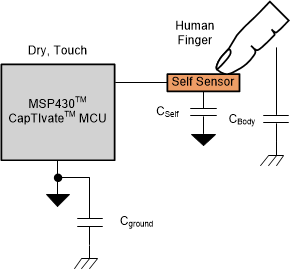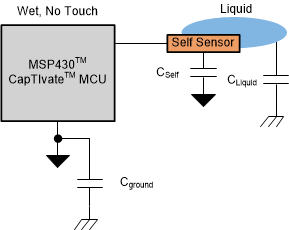TIDUE90 July 2018
- Description
- Resources
- Features
- Applications
- Design Images
- 1System Description
- 2System Overview
- 3Hardware, Software, Test Requirements, and Test Results
- 4Design Files
- 5Software Files
- 6Related Documentation
- 7About the Author
2.2.3.1 Self Capacitance
The self capacitance method measures changes in capacitance with respect to earth ground. When a user's finger touches the self capacitance sensor electrode, the finger provides a path that couples the sensor to earth ground (see Figure 3). Because of this, an additional touch capacitance is added to Cself, which increases the capacitance. When a liquid covers the touch surface, the liquid also provides a path that couples the sensor to the surrounding ground on the sensor PCB. The additional capacitance Cliquid is added to Cself and increases the capacitance.
With the self capacitance method, both the finger touch and liquid presence increase the sensed capacitance, which means that the self capacitance method is sensitive to liquid on the touch surface.
 |
 |
|
| Human finger provides a path for coupling the sensor to earth ground, which increases the capacitance CSelf. | Liquid covers the touch surface also provides a path for coupling the sensor to the surrounding ground or other components, which increases the capacitance CSelf. | |
|
Figure 3. Influence of Liquid on Self Capacitance Method
|
||